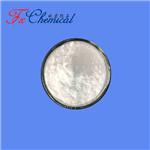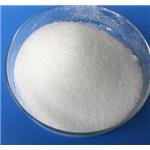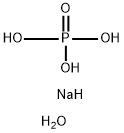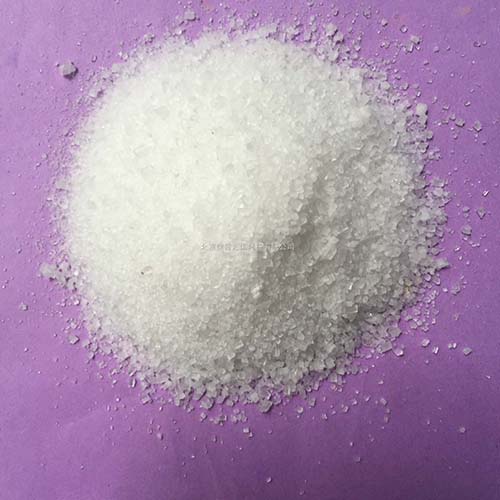Sodium Dihydrogen Phosphate Dihydrate: Applications in Nanocomposite Synthesis and its Preparation Method
General Description
Sodium dihydrogen phosphate dihydrate is an important inorganic compound widely used in biomaterial and nanocomposite synthesis. It serves as a reliable phosphorus source, particularly in the formation of hydroxyapatite through methods like microwave-assisted hydrothermal synthesis. This compound enhances the production of pure hydroxyapatite with diverse morphologies, offering flexibility in reaction parameters. Environmentally, its surfactant-free synthesis minimizes energy consumption and reduces post-treatment costs, aligning with sustainable practices. Additionally, sodium dihydrogen phosphate dihydrate can be prepared through neutralization of phosphoric acid with sodium hydroxide or industrially from other sodium phosphate salts, leading to effective production methods in various applications.

Figure 1. Sodium dihydrogen phosphate dihydrate
Applications in Nanocomposite Synthesis
Introduction to Sodium Dihydrogen Phosphate Dihydrate
Sodium dihydrogen phosphate dihydrate is a crucial inorganic compound widely applied in various scientific and industrial fields. This compound serves as an essential phosphorus source, particularly in processes related to biomaterials and nanocomposite synthesis. The unique properties of sodium dihydrogen phosphate dihydrate, including its ability to release phosphate ions in aqueous solutions, make it particularly valuable in the synthesis of hydroxyapatite. In the context of nanocomposites, sodium dihydrogen phosphate dihydrate enhances the formation of hydroxyapatite structures due to its role in controlling the mineralization process and morphology. Researchers have increasingly focused on this compound to develop innovative and sustainable synthesis methods.
Role in Nanocomposite Synthesis
In the synthesis of cellulose/hydroxyapatite nanocomposites, sodium dihydrogen phosphate dihydrate has been identified as a reliable phosphorus source. The use of this compound enables the production of pure hydroxyapatite without the occurrence of unwanted byproducts. By employing sodium dihydrogen phosphate dihydrate in microwave-assisted hydrothermal methods, scientists can finely tune the reaction parameters to obtain hydroxyapatite with various morphologies. For instance, adjustments in temperature and heating time significantly influence the resulting morphology, leading to diverse structures such as nanorods and spherical particles. This flexibility in synthesis is attributed to the unique interaction of sodium dihydrogen phosphate dihydrate with cellulose and other forming agents in the reaction milieu.
Environmental and Economic Benefits
The use of sodium dihydrogen phosphate dihydrate in green synthesis strategies offers notable environmental and economic advantages. Its surfactant-free approach not only minimizes energy consumption during production but also eliminates the need for complex post-treatment procedures to remove surfactants. This simplicity not only reduces production costs but also aligns with principles of sustainable chemistry, as it lessens the environmental impact associated with surfactant usage. Consequently, sodium dihydrogen phosphate dihydrate stands out as an optimal choice for researchers aiming to develop eco-friendly nanocomposites without compromising on the quality or effectiveness of the final products. Through its applications, sodium dihydrogen phosphate dihydrate can significantly contribute to advances in material sciences and sustainable manufacturing processes. 1
Preparation Method
Preparation of Sodium Dihydrogen Phosphate Dihydrate
Sodium dihydrogen phosphate dihydrate is primarily prepared by the neutralization of phosphoric acid with sodium hydroxide. The reaction involves phosphoric acid reacting with sodium hydroxide to produce sodium dihydrogen phosphate and water. Specifically, phosphoric acid reacts with sodium hydroxide to yield sodium dihydrogen phosphate, a compound commonly used in various industrial applications. In this process, one molecule of phosphoric acid reacts with one molecule of sodium hydroxide to form one molecule of sodium dihydrogen phosphate and one molecule of water. To obtain the dihydrate form, additional water is incorporated into the final product. 2
Industrial Preparation of Sodium Dihydrogen Phosphate Dihydrate
On an industrial scale, the preparation of sodium dihydrogen phosphate dihydrate typically involves the conversion of sodium phosphate salts. Initially, dicalcium phosphate is treated with sodium bisulfate, resulting in sodium dihydrogen phosphate and calcium sulfate as a by-product. After this, the resultant sodium dihydrogen phosphate solution is carefully crystallized to form the dihydrate. This process involves controlling the temperature and concentration of the solution to ensure that the sodium dihydrogen phosphate crystallizes with two water molecules, yielding the dihydrate form. The crystallized sodium dihydrogen phosphate dihydrate is then filtered, dried, and processed for various industrial uses. 2
References:
[1] LIAN-HUA FU. Microwave-Assisted Hydrothermal Synthesis of Cellulose/Hydroxyapatite Nanocomposites.[J]. Polymers, 2016, 8 9. DOI:10.3390/polym8090316.You may like
Related articles And Qustion
See also
Lastest Price from Sodium dihydrogen phosphate dihydrate manufacturers

US $0.00/KG2025-04-21
- CAS:
- 13472-35-0
- Min. Order:
- 1KG
- Purity:
- 98%min
- Supply Ability:
- 30tons/month

US $3.60/kg2025-04-18
- CAS:
- 13472-35-0
- Min. Order:
- 1kg
- Purity:
- ≥99%
- Supply Ability:
- 3000tons/month



